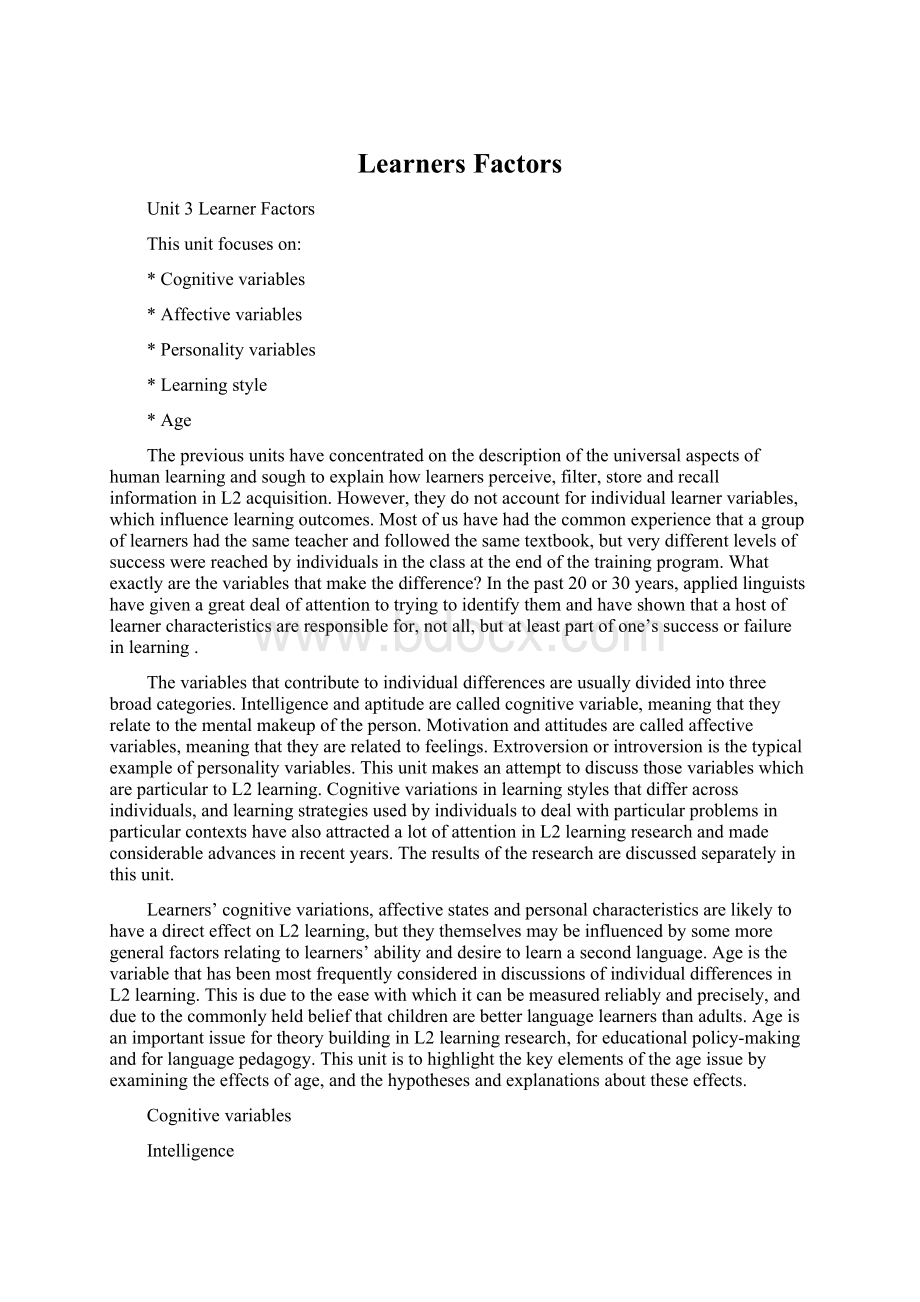Learners Factors.docx
《Learners Factors.docx》由会员分享,可在线阅读,更多相关《Learners Factors.docx(26页珍藏版)》请在冰豆网上搜索。

LearnersFactors
Unit3LearnerFactors
Thisunitfocuseson:
*Cognitivevariables
*Affectivevariables
*Personalityvariables
*Learningstyle
*Age
Thepreviousunitshaveconcentratedonthedescriptionoftheuniversalaspectsofhumanlearningandsoughtoexplainhowlearnersperceive,filter,storeandrecallinformationinL2acquisition.However,theydonotaccountforindividuallearnervariables,whichinfluencelearningoutcomes.Mostofushavehadthecommonexperiencethatagroupoflearnershadthesameteacherandfollowedthesametextbook,butverydifferentlevelsofsuccesswerereachedbyindividualsintheclassattheendofthetrainingprogram.Whatexactlyarethevariablesthatmakethedifference?
Inthepast20or30years,appliedlinguistshavegivenagreatdealofattentiontotryingtoidentifythemandhaveshownthatahostoflearnercharacteristicsareresponsiblefor,notall,butatleastpartofone’ssuccessorfailureinlearning.
Thevariablesthatcontributetoindividualdifferencesareusuallydividedintothreebroadcategories.Intelligenceandaptitudearecalledcognitivevariable,meaningthattheyrelatetothementalmakeupoftheperson.Motivationandattitudesarecalledaffectivevariables,meaningthattheyarerelatedtofeelings.Extroversionorintroversionisthetypicalexampleofpersonalityvariables.ThisunitmakesanattempttodiscussthosevariableswhichareparticulartoL2learning.Cognitivevariationsinlearningstylesthatdifferacrossindividuals,andlearningstrategiesusedbyindividualstodealwithparticularproblemsinparticularcontextshavealsoattractedalotofattentioninL2learningresearchandmadeconsiderableadvancesinrecentyears.Theresultsoftheresearcharediscussedseparatelyinthisunit.
Learners’cognitivevariations,affectivestatesandpersonalcharacteristicsarelikelytohaveadirecteffectonL2learning,buttheythemselvesmaybeinfluencedbysomemoregeneralfactorsrelatingtolearners’abilityanddesiretolearnasecondlanguage.AgeisthevariablethathasbeenmostfrequentlyconsideredindiscussionsofindividualdifferencesinL2learning.Thisisduetotheeasewithwhichitcanbemeasuredreliablyandprecisely,andduetothecommonlyheldbeliefthatchildrenarebetterlanguagelearnersthanadults.AgeisanimportantissuefortheorybuildinginL2learningresearch,foreducationalpolicy-makingandforlanguagepedagogy.Thisunitistohighlightthekeyelementsoftheageissuebyexaminingtheeffectsofage,andthehypothesesandexplanationsabouttheseeffects.
Cognitivevariables
Intelligence
Intheearly20thcentury,intelligencewasconsideredanimportantfactorforforeignlanguagelearning.Itwasalsobelievedthatforeignlanguagelearningactuallyhelpedtodevelopintelligence,andeventodaysomepeopleinsistthatlearningLatinhelpsbuildintellectualpowersevenifitmaynotbeausefullanguagetoknow.
Traditionally,intelligenceisdefinedandmeasuredintermsoflinguisticandlogical-mathematicalabilities.ItwasproposedinAusubel’smeaningfullearningmodel(1968)thathighintelligencewouldnodoubtimplyaveryefficientprocessofstoringitemsthatareparticularlyusefulinbuildingconceptualhierarchiesandsystematicallypruningthosethatarenotuseful.In1983,H.Gardnergaveamorecomprehensivepictureofintelligenceandmaintainedthatthedefinitionlfintelligenceshouldbroadlyincludesevendifferentaspects:
linguisticabilities;logical-mathematicalabilities;spatialintelligence(theabilitytofindone’swayaroundanenvironment,toformmentalimagesofrealityandtotransformthemreadily);musicalintelligence(theabilitytoperceiveandcreatepitchandrhythmicpatterns);bodily-kinestheticintelligence(finemotormovement,athleticprowess);interpersonalintelligence(theabilitytounderstandothers,howtheyfeel,whatmotivatesthem,howtheyinteractwithoneanother);andintrapersonalintelligence(theabilitytoseeoneself,todevelopasenseofself-identity).Fromthebroaddefinitionofintelligence,wecaneasilydiscernthatintelligencereferstotheunderlyingabilitytolearnandtousevariousacademicskills.Thisgeneralintelligenceisusuallyabbreviatedto‘g’.
Towhatextent,however,doesthe‘g’factorinfluenceL2learning?
Gardner’snotionofintelligenceisofcrucialimportancetosecondlanguagesuccess.Musicalintelligencecouldexplaintherelativeeasethatsomelearnershaveinperceivingandproducingtheintonationpatternsofalanguage.Bodily-kinestheticmodesareconnectedwiththelearningofthephonologyofalanguage.Interpersonalintelligenceisofimportanceinthecommunicativeprocess.Intrapersonalfactorssuchasmotivation,attitudeandpersonalitymayhavedefiniteimpactonsecondlanguagelearning.
DuringtheprocessofL1acquisition,intelligenceisnotfoundasadecisivefactor,exceptformentallyretardedchildren.Mostchildrenareabletogetcompletegrammarknowledge.Fromthispoint,wecouldsaythatintelligenceisalsonotadecisivefactorinforeignlanguageacquisition.However,someresearcherssuggestthatintelligencetestscanpredictsuccessinL2learningandothersbelievethatthereissomeseparate,specialmentalconstructthatdeterminesouraptitudeforlanguagelearning.
In1979,ComminsofferedamoresophisticatedexplanationoftheconnectionbetweenintelligenceandL2proficiency.Hedistinguishestwokindsoflanguageabilitythatallnativespeakersofalanguagemayhave.ThefirstiscalledCognitive/AcademicLanguageProficiency(CALP)andthesecondistermedBasicInterpersonalCommunicationSkill(BICS).CALPinvolvesrecognizingthelinguisticformsofthelanguageandhowtheyrelatetooneanotherinlongersequencesofspokenorwrittentext.LevelsofCALParejudgedbythenativespeakers’linguisticknowledgeofthelanguageandtheirabilitytousethisknowledgepreciselyandflexibly.EvidenceofsuchCALPabilitycanbeprovidedbythecompetenceoneshowsindoinglanguagetestsandexercises,andbytheproficiencywithwhichindividualsareabletoproducelongerwrittenassignmentsordissertations.Proficiencyatthistypeoflanguageuseisaffectedbyaperson’s‘g’,andnativespeakershavethisabilitytodifferentextentsintheirL1.BICSareskillswhichdetermineoralfluencyandtheabilitytouselanguageappropriatelytocommunicate.Theyare‘basic’inthesensethattheyaredevelopednaturally.Allnormalnativespeakershavethisabilityanditisunaffectedbyanindividual’s‘g’.AccordingtoCummins,thesetwokindsofabilitiesareinterdependentandtakeeffectinbothnativelanguageandforeignlanguagelearning.Differentmeasuresoflanguageproficiencyarelikelytousebothabilitiesinvaryingproportions.
Cummins’distinctionbetweenCALPandBICSexplainsanumberofresearchfindings.Forinstance,Genesee’experiment(1976)foundthatintelligencewasstronglyrelatedtothedevelopmentofacademicL2Frenchlanguageskills(reading,grammarandvocabulary),butnotrelatedtooralproficiency.ItseemsthattestsofgeneralintelligencemaybeabletopredicteventualL2proficiencyinCALP-likeareasoflanguage,butnotinthoserequiringBICSability.In1969,ChastaincomparedIQscoreswiththeachievementresultsofstudentslearningaforeignlanguagebytwodifferentmethods,audiolingualismandcognitivecode.Chastainreportedasignificantcorrelationwhenstudentsweretaughtbythecognitivecodemethodwhichemphasizeddeductivereasoningskills,butnonewhenstudentsweretaughtbytheaudio-lingualmethodthatemphasizedhabitformation.
Itisdifficultforustoknowhowmuchintelligenceinfluencesforeignlanguagelearning,becausegivinganaccuratedefinitionisnotaneasyjob.IntelligencemaybeapowerfulpredictorofsuccessintheL2classroom,whenthisconsistsofformalteachingmethods,butmuchlessinnaturalisticL2acquisition,whenL2knowledgeisdevelopedthroughlearninghowtocommunicateinthetargetlanguage.
Aptitude
Aptitudereferstothespecialabilityinvolvedinlanguagelearning.Languageaptitudeisthoughttobeacombinationofvariousabilitiesinlanguagelearning.ThetermwasoriginallycreatedbyJohnCarroll,apsychologistwhodevelopedatestcalledTheLanguageAptitudeTesttopredictperformanceofstudentsinforeignlanguagelearning.CarrollidentifiedfourindependentabilitiesconstitutingL2learningtalent:
(1)Phoneticcodingability—theabilitytoidentifydistinctsounds,toformassociationsbetweensoundsandthesymbolsthatrepresentthemandtoretaintheseassociations.Thisabilityisseenasrelatedtotheabilitytospellandtohandlesound—symbolrelationships.
(2)Grammaticalsensitivity—theabilitytorecognizethegrammaticalfunctionofwordsinsentencecontexts.
(3)Inductivelanguagelearningability—theabilitytoidentifypatternsofcorrespondenceandrelationsbetweenformandmeaning.
(4)Rotelearningabilitythe–theabilitytoformandrememberassociationsbetweenstimuli.Thisabilityishypothesizedtobeinvolvedinvocabularylearning.
TwoofthebestknowntestsaretheModernLanguageAptitudeTest(MLATforshort)andtheLanguageAptitudeBattery(LABforshort).
TheMLATconsistsoffivesubtests:
Numberlearning;Phoneticscript;Spellingclues;WordsinsentencesandPairedassociates.Phoneticcodingabilityischieflymeasuredbythe“phoneticscript”subtest,whichtestsbothsound—symbolassociationandauditorydiscrimination,andgrammaticalsensitivityistestedbythe“wordsinsentences”subtest,whichteststheabilitytorecognizethefunctionofwordsinthesentence.
P.Pimsleur(1966)